 Violet rowweed (Lepista irina) is a species of fruiting bodies belonging to the Ryadovkovye family. It has an interesting cap color and a pleasant floral (not perfume) smell. This is a good edible mushroom, which in terms of taste is equated to a purple row. However, some lovers of “silent hunting” do not dare to take and prepare this type of fruiting body. The fact is that many mushroom pickers who do not have experience can mistake a violet row for a poisonous toadstool. In addition, a light violet aroma can be retained in its structure even after heat treatment. But many regard this feature as an opportunity to give the dish originality and piquancy.
Violet rowweed (Lepista irina) is a species of fruiting bodies belonging to the Ryadovkovye family. It has an interesting cap color and a pleasant floral (not perfume) smell. This is a good edible mushroom, which in terms of taste is equated to a purple row. However, some lovers of “silent hunting” do not dare to take and prepare this type of fruiting body. The fact is that many mushroom pickers who do not have experience can mistake a violet row for a poisonous toadstool. In addition, a light violet aroma can be retained in its structure even after heat treatment. But many regard this feature as an opportunity to give the dish originality and piquancy.
In order to more clearly get acquainted with the violet row, we suggest that you look at the photo and description belonging to this species.
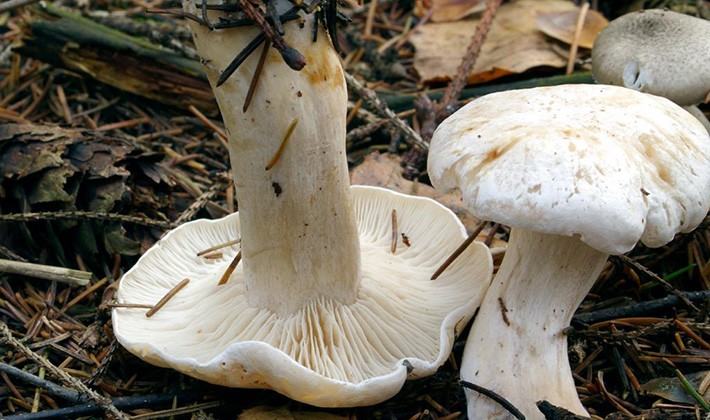
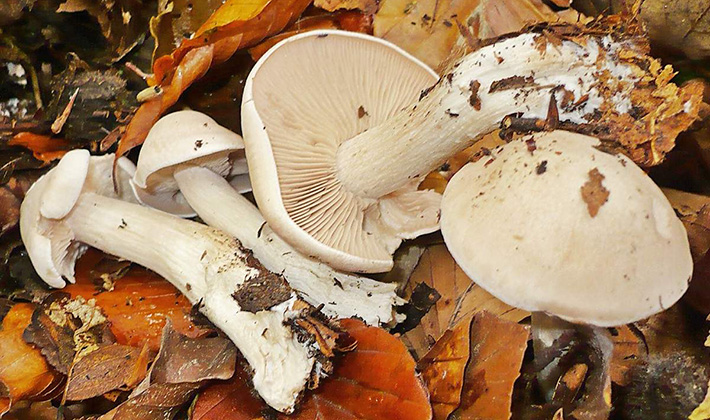
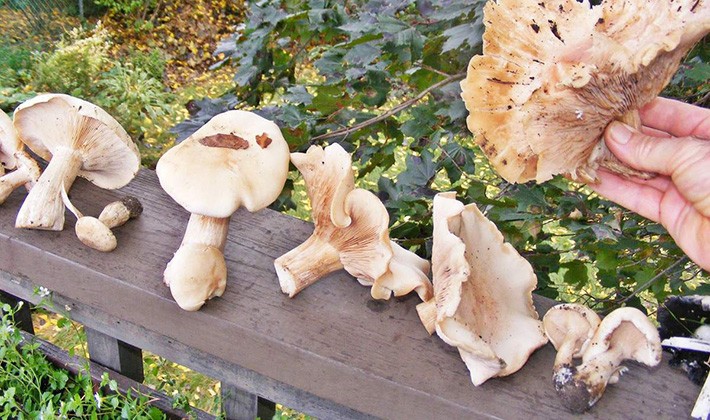
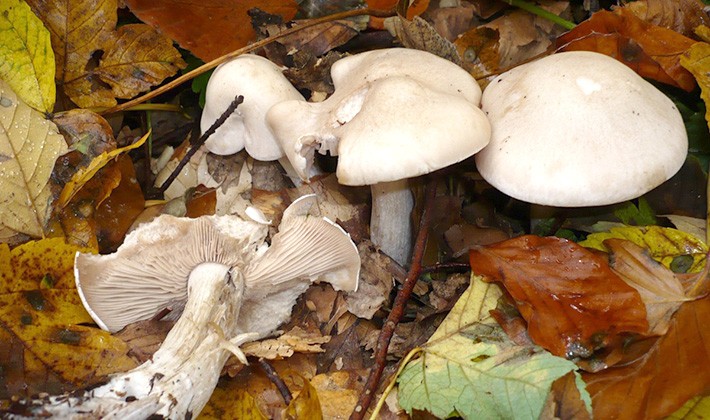
[ »wp-content/plugins/include-me/ya1-h2.php»]
Description of the violet row (Lepista irina)
Latin name: To appease irina.
Family: Ordinary (Tricholomataceae). Some mycologists have transferred this type of fungus to the genus Govorushka (Clitocybe).
Synonyms: violet lepista. Latin synonyms: Clitocybe irina, Gyrophila irina, Tricholoma irinum, Agaricus irinus, Rhodopaxillus irinus.
Hat: quite large, 5-15 cm in diameter, fleshy, in young specimens it is presented in the form of a sphere. Then it acquires a bell-shaped form and already in deep adulthood becomes prostrate, with wavy uneven edges. The surface of the cap is dry, silky and smooth to the touch. The color is white with a noticeable pink tinge, which becomes reddish brown at maturity. The area located in the very center of the cap has a darker shade than along the edges.
[ »»]Leg: 5-11 cm high, up to 2 cm thick, strong, fibrous, slightly widened at the base, sometimes even. The photo shows that the violet leg is covered with characteristic vertical strokes, but they can not always be seen. The ring-skirt on this part of the fruiting body is completely absent. The surface of the stem has the same color as the cap – whitish, pale or pink-cream.
Pulp: thick, dense, white in color, with a pleasant floral smell and a sweetish taste. In wet weather, its structure becomes watery. The flesh of the leg is fibrous and rather hard, especially at the base.
Records: free, frequent, adhering to the stem, sometimes not reaching it. The color of the plates in young mushrooms is whitish, after which they turn pink, and in maturity a delicate shade resembling the color of cinnamon is noticeable.
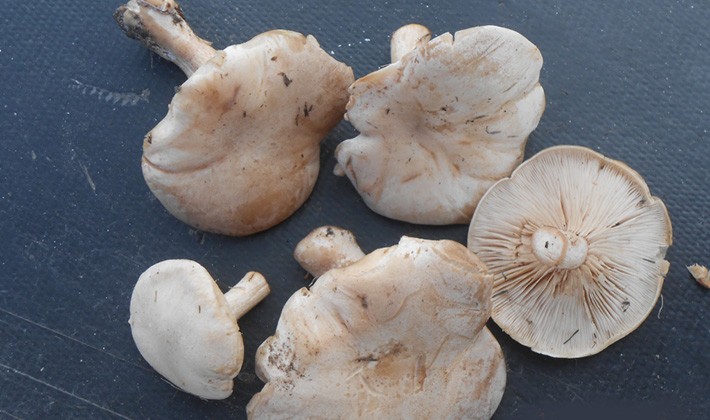 [ »»]Edibility: edible mushroom, but cases of mild poisoning have been known. Apparently, this is due to the fact that the fruiting body was collected in environmentally polluted places – near highways, factories and other industrial enterprises.
[ »»]Edibility: edible mushroom, but cases of mild poisoning have been known. Apparently, this is due to the fact that the fruiting body was collected in environmentally polluted places – near highways, factories and other industrial enterprises.
Similarities and differences: this row can sometimes be confused with a smoky talker. However, the latter is distinguished by a cottony, loose pulp and plates descending along the leg. In addition, the talker has a strong perfume smell, while the pulp of the violet leaf has a delicate floral aroma. In addition, this mushroom is very similar to the edible truncated row (Tricholoma truncatum). Both mentioned species have almost the same smell and color, but the violet row has a higher leg. However, even if you confuse these mushrooms, then you should not have cause for concern. Row truncated – an edible species with good taste. It is known that it is also suitable for eating fresh and pickled.
Distribution and use of violet rowing
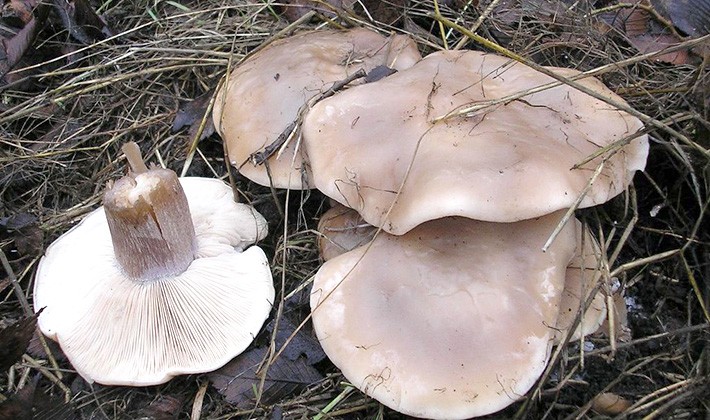 Distribution: European countries, as well as North America. In Our Country, the violet row can be found in the Primorsky and Khabarovsk Territories, as well as in the Amur Region. It grows in groups or rows, choosing mixed, coniferous and deciduous forests. It occurs in autumn (late August-October), forming “witch rings”.
Distribution: European countries, as well as North America. In Our Country, the violet row can be found in the Primorsky and Khabarovsk Territories, as well as in the Amur Region. It grows in groups or rows, choosing mixed, coniferous and deciduous forests. It occurs in autumn (late August-October), forming “witch rings”.
The peak of mushroom collection is in September-early October.
If weather conditions allow, then the fruiting body can be found even in November and December. In this case, you need to pay special attention to open places: the edge of the forest, edges and meadows. It grows simultaneously with the purple row (Lepista nuda) – an edible mushroom. Often both species are found in the same places.
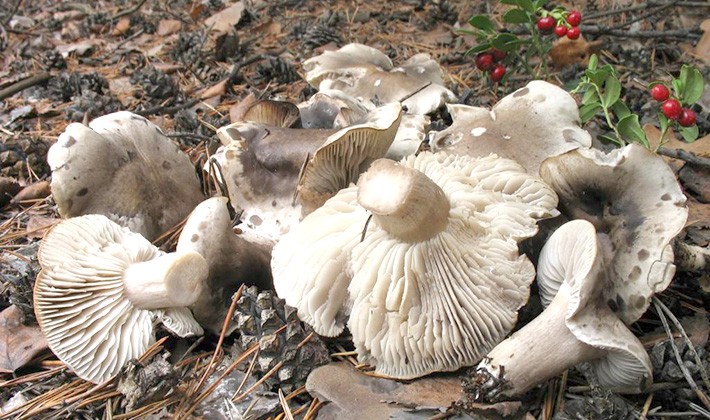 Application: there are many processing options for violet row mushrooms. Most often they are marinated, salted and fried. Sometimes housewives freeze the fruiting body for the winter. The mushroom requires preliminary boiling for 20 minutes.
Application: there are many processing options for violet row mushrooms. Most often they are marinated, salted and fried. Sometimes housewives freeze the fruiting body for the winter. The mushroom requires preliminary boiling for 20 minutes.
The above photos and description of the violet row mushroom will help you thoroughly prepare for the “gribalka” and not miss a single edible mushroom.
However, never forget the main rule when collecting fruiting bodies:not sure – don’t pick!».









